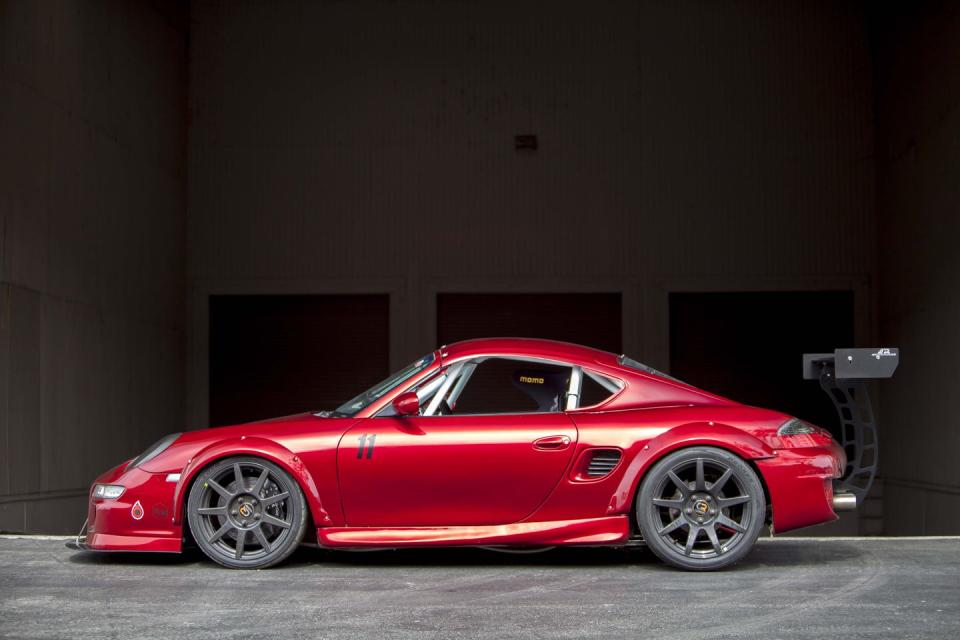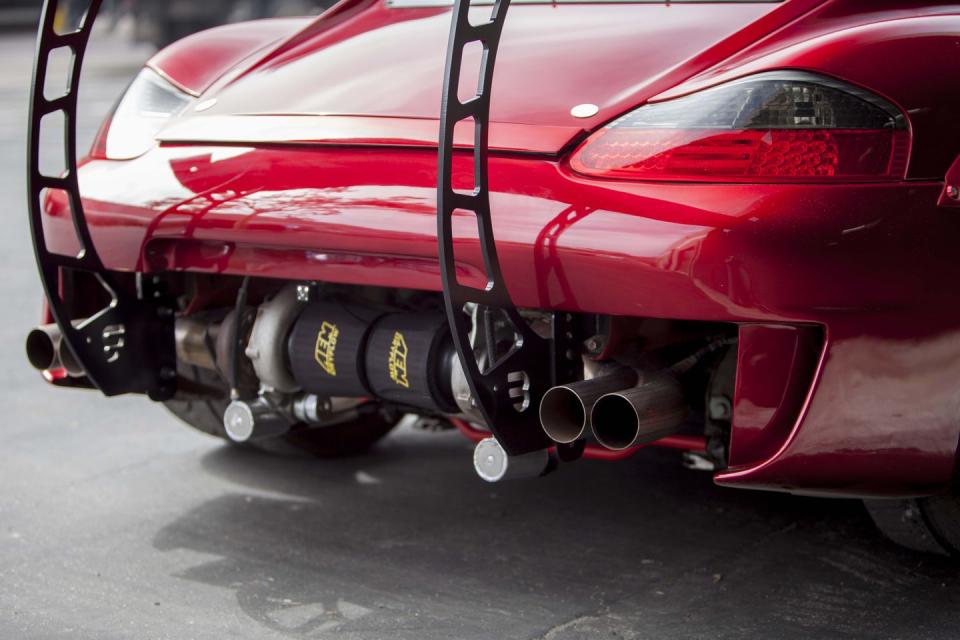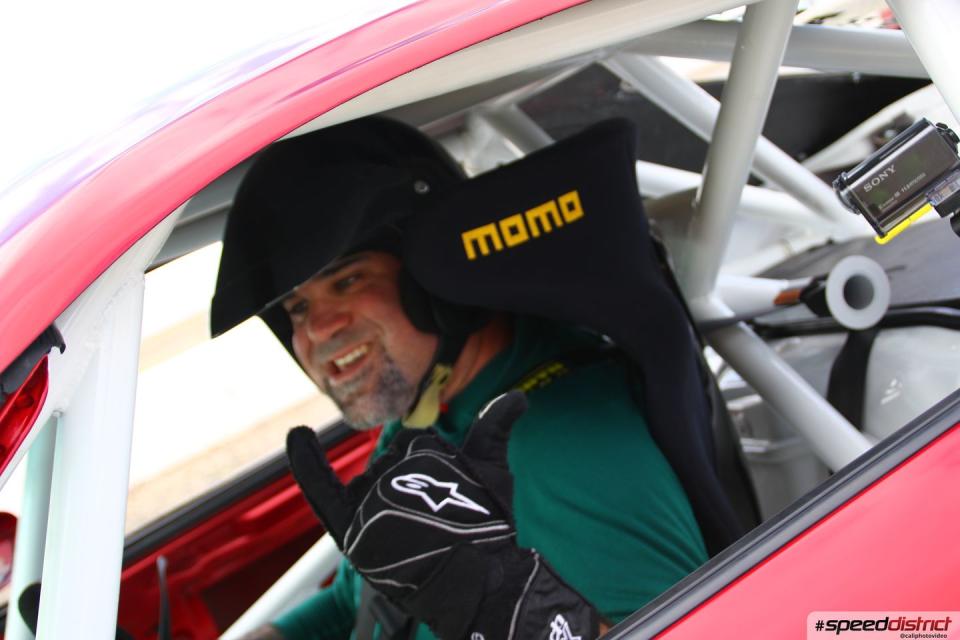First Drive: Center Seat Porsche Boxster

Bisi Ezerioha likes a challenge.
Just take a gander around the quiet, airy workshop bearing his name, Bisimoto Engineering, and you’ll see the oddest collection of modified cars you can imagine. In the middle, a Honda Odyssey, bagged to the floor with an intercooler jutting like a bad under bite from its front bumper. It makes 1,000 HP. Then there’s a four-cylinder Honda Insight capable of running nine second quarter miles without a turbocharger. In the back there’s a dozen or so 911 shells, like blank canvases for Bisi when he finds a free moment. Unlike the SEMA special Japanese and Korean stuff, those are all his. They're surrounding, like loyal subjects, the sky blue, 800-horsepower Bisimoto 1976 Carrera I drove for /TUNED. It's the scariest properly functioning car I’ve ever tested.

A drag racer and chemical engineer at heart, Bisi has made a career out of upending assumptions. For instance, that 1976 Carrera uses a Porsche M96 engine, modified with twin turbochargers and running drive-by-wire CANBUS, like a modern car. If that engine sounds familiar, that's because it's from the 996-generation Carrera. Yeah, the one with the IMS Bearing failure issue.

The bearing would seize, the engine would go boom, and your $22,000 used Carrera would require a $20,000 engine replacement. Many Porsche owners aren’t exactly fans. But Bisi wanted to show the potential in the unloved.
I've never doubted that this man could build an engine. The ’76, like I said, was terrifying. The Turbo Odyssey would light the front tires up in any gear, at any speed. But Bisi, a lifetime drag racer, wanted to expand his horizons a bit, and learn how to make a car go around corners.
Which brings me to this: a 2000-model year, 986-series Porsche Boxster, a car that certainly fills the “unloved” requirement. These cars are becoming super cheap, well under $10,000 in many cases, in part because they are so expensive to maintain and repair in comparison to their performance. That’s not to say they are bad cars when they are working, but buying a cheap one is truly a roll of the dice.

This one left the factory with a 217-hp, 2.7L flat-six, a version, not-coincidentally, of the previously mentioned M96. Bisi acquired it with a blown engine for $4,000. He had previously added twin-turbos to his wife, Heidi’s, Cayman road car, good for 480 hp with air conditioning, but called it, “a heavy mess on the track.” He wanted to go lighter. Perfect balance was the goal.
Bisimoto rebuilt the engine with Golden Eagle Sleeves, Bisimoto Rods, Traum Pistons, ARP studs, and twin 52mm Precision ball-bearing turbochargers. It runs an AEM Infinity engine management system with a Rywire harness, a Spearco liquid-to-air intercooler, custom headers, Bisimoto turbo drip tanks, multiple CSF radiators, and a fuel cell full of E85. The power gets to the ground through, believe it or not, the stock five-speed gearbox mated to a Quaife limited-slip differential and upgraded Action clutch and flywheel.
All this stuff is good for 420 horsepower at the wheels in normal mode, with an overboost function for short bursts of over 100 extra wheel horsepower. Um, yes please. A new 911 Turbo S makes about 520 HP through the wheels and weighs 3,500 pounds. This Boxster weighs a thousand pounds less. Yikes.

In the chassis department, nothing has been left alone. Despite the insane power, handling is the point of this entire exercise. The stock Boxster brought a 47/53 front/rear balance to the table, so Bisi went with universally-liked KW Variant 3 coil overs and equally well regarded carbon fiber wheels from Carbon Revolution. It has a full roll cage and a Tarox 8-piston big brake kit. In theory, all this should do the trick, especially with sticky Toyo R888 tires.
Outside, Bisi went with Extreme Dimensions side skirts, front and rear bumpers, and installed his own rivet-on fender flares. There’s a huge APR GT wing in the back, and an APR carbon splitter in the front. But the party trick here is the carbon fiber roof, molded from a 987-generation Cayman. The proportions of it are juuuuust enough to make you look at it and go, “What’s different here?” Bisi had five of these roof panels made; each one costs more than the donor Boxster to which it is installed.
Oh, and you sit in the middle.

Bisi took the entire interior apart and reconfigured it as a center driving position, like a McLaren F1. There’s a fixed Momo race seat with a Rothfab Foot Plate and Wilwood pedal box. The pedals are adjustable for different sized drivers. The Rennline shifter mount is built atop a perfectly placed custom pedestal with battery cutoff, ignition, and a starter switch cleanly mounted on the shift stand. On the exposed steering column sits an AEM CD-7 Digital Dash, configured with a Lamborghini Aventador-style skin. The center rearview mirror is digital, which defies the laws of optics and lets you see more than your own face in it. A red button looms on the MOMO steering wheel with the words "TO PASS" printed on it. If that doesn’t excite you, you’re probably dead inside. That’s how you access those extra hundred ponies when you need ‘em.
According to Bisi’s corner balancing scales, the car is 2,550 lbs wet and has 49.9/50.1 left-to-right balance with the center drive.
“The hardest part of a center-drive conversion is retaining the integrity of the original body structure. There is a central tunnel, and if you have to make some cuts, you want to reinforce that.”

A welded-in full cage adds to the structural rigidity far beyond the factory specs.
“Then the big thing you worry about is moving the steering wheel to the middle,” Bisi says. There are extra knuckles in the steering shaft to move it to the center. “These cars are known for good steering. You’d hate to go through the effort of converting to center drive for balance, only to ruin the steering.”
This car is obviously not street legal. So Bisi meets me at Buttonwillow Raceway to run a few laps. The theater of the center-seat Porsche is certainly on point. Nothing makes you understand you’re about to have an abnormal driving experience like sitting in the middle of a Boxster with a Cayman’s roof, with the shifter on a stanchion next to you, and the constant whistling of the turbos, resonating through a bare metal firewall.
Fortunately, it doesn’t disappoint. Pulling out of pit road and on to the track, you instantly realize you’re in something pretty special. The turbos spool up and blow off like a hero car in The Fast and the Furious on upshifts. The torque is breathtaking and comes on from 3,500 RPM, peaking out around 6,300 RPM. The stock gears, finely tuned from Stuttgart to match with 220 horsepower, seem awfully short with a 6,800 RPM redline. Nevertheless, it's fast and planted once you get some heat in the R888’s. The steering is very light, and accurate, but a bit short on feel.

I provoke both understeer and oversteer with the throttle while the tires are cold, and while I can easily tell what’s happening with the front wheels, that information isn’t coming from my hands. Frankly, I can’t recall the last time I drove a 986-era Boxster, so if there ever was a comparison in that noggin of mine, it’s gone now. I certainly wouldn’t complain if it hadn’t already been a point of conversation.
Driving from the center doesn’t meaningfully change the experience in terms of handling and feel, but sitting in the center is absolutely a fun and welcome novelty. It turns what would otherwise be a fast, if somewhat ordinary, road car into what feels like a fat man’s LeMans prototype. From the center, the Boxster seems to wrap around you. Your body and eyes are equidistant from the corner curbing, regardless of which direction you’re turning the wheel and adds a totally unique flavor to the track day experience. The cabin is light and airy. Everything but the wheel and shifter are impressively far away, offering a sense of security in the cabin, especially for a larger driver.
As far as racecars go, this cockpit is huge. Any seat you can imagine will fit. Even better, on nice days, test days, whatever your excuse, the carbon roof snaps off with about a dozen pop-rivets, and weighs less than 10 lbs. You can lay it on a blanket and run as a speedster for an even more immersive experience.

It only took about a lap and a half before I was laughing and cackling about how much fun I was having driving this thing. It’s a lot of what you love about Porsche, the smoothness of the flat-six, the sound, combined with the triumph of the tuner underdog, who takes the unloved, underpowered engine and turns it into something fizzy and exciting. Something that actually works! The car is quick and with that extra hundred horsepower on the button, has enough power to thrill even the most jaded of souls, like me.
If I had a complaint, it’s that Bisi paired a car with a ridiculous amount of horsepower with manually powered brakes, like he did for his terrifying, 800-hp 1976 911 Turbo. That’s right; those Tarox 8-Piston racing brakes aren’t powered. If we’re at a VARA weekend in an MGA Speedster or something that weighs less than a GoldWing with 100 horsepower, sure, manual brakes. But this thing makes five hundred horsepower and we’re talking about road course work. It needs power brakes.

Heel-toe shifting is awfully difficult work. And with this gear ratio set on this race track, you need to do a lot of it. The car is fast enough to require another upshift per straight, and therefore another downshift at the end, compared to a stock Boxster. At the end of one session, I overcooked the last corner before the front straight and got the car a little dirty. I could do what most people do and blame the lack of power brakes, or I could do what I normally do and blame my own bad driving. Feel free to watch the video and judge for yourself, but honestly my right foot just got too tired. And I have a big, strong right foot.
Braking aside, I have to say the car is remarkably stable, planted, predictable, and fun. It rides on the stiff side, but acceptably so for a track car, and it isn’t upset by my aggressive taking of curbs. It turns in well, and puts the power to the ground in a controlled way. The power does not overwhelm the chassis, which is exactly what you want.
Believe it or not, there is actually a point to this exercise beyond Bisi just learning what road course setup, handling, and balance is all about. Some kind folks at the Porsche Owners Club have been looking to start a new spec racing series–something more exciting and faster than Spec Boxster, but not as expensive to run as a Cup car. That's why Bisi has those five extra carbon fiber roofs sitting in his shop. While this first model is an engineering exercise, a test mule with candy paint, there will be five more. They will be slightly more ‘finished,” and Bisi wants to use 3.4 liter engines, rather than the 2.7 he has now.

“I wanted to show you can do something with the 2.7, but more importantly, I had it laying around,” he chuckles. “A paying customer is going to want a bit more displacement for that torque, the six-speed gearbox, and we can rely on the turbochargers a bit less; go a bit smaller with them.”
But why doesn’t he just build bigger, naturally aspirated engines if it’s for spec racing? Don’t customers want N/A reliability?
“You see how it looks on the rear bumper with the turbos hanging down there like that. That’s the best marketing I have; just people seeing that. You feel how exciting the turbo engine is to drive, and I can make the turbo engine very reliable with small turbos and more displacement. It will be the best of both worlds.”
“But more importantly….” I interject.
“Yes, yes,” Bisi stops me in my tracks. “There will be power brakes.”
Thanks to Cali Photography for the on-track shots! Check them out on Instagram.
You Might Also Like


